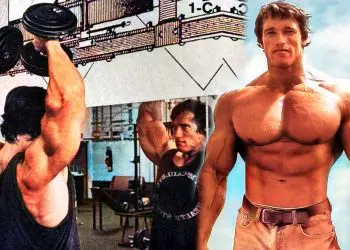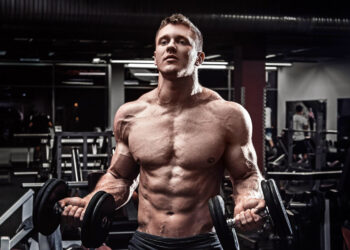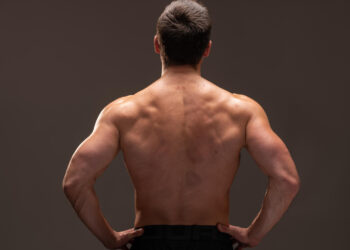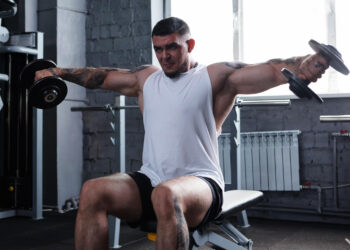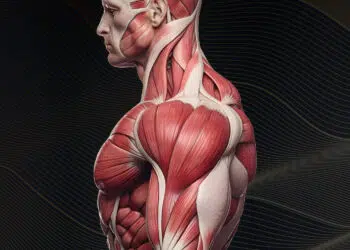While your knees may disagree, your shoulders are probably the hardest working joints in your body. You can’t train your pecs, lats, or delts without using your shoulders, and some arm and lower body exercises involve your shoulders too.
That’s why shoulder pain can be so debilitating. Painful, creaky shoulders can make almost everything except riding a stationary bike uncomfortable, unpleasant, and maybe even impossible.
That’s why good shoulder mobility and stability are so important. As lifters, we NEED to look after our shoulders so that they do not become a liability. Take it from someone with severely calcified shoulder joints; you’ll miss having pain-free shoulders!
One way to keep your shoulders in good shape is to ensure that you train all three deltoid heads (anterior, medial, and posterior) equally and also strengthen the underlying rotator cuff muscles.
One way to do this is to add the Cuban press to your shoulder workouts.
According to legend, this exercise was invented to strengthen and injury-proof the shoulders of Cuban Olympic lifers. Olympic weightlifting is notoriously hard on the shoulders. It was then popularized by famous strength coach Charles Poliquin back in the early 2000s.
Level Up Your Fitness: Join our 💪 strong community in Fitness Volt Newsletter. Get daily inspiration, expert-backed workouts, nutrition tips, the latest in strength sports, and the support you need to reach your goals. Subscribe for free!
In this article, we reveal why the Cuban press deserves to be part of your workouts and how to do it.
Cuban Press – Muscles Worked
The Cuban press is not just a compound exercise; it’s a combination of three individual exercises rolled into one. As such, it involves lots of different muscles. The main muscles trained by the Cuban press are:
Trapezius and rhomboids – covering much of your upper back, the trapezius is a large diamond-shaped muscle. It’s responsible for elevation, retraction (working with the rhomboids), and depression of your shoulder girdle. The traps are involved in all three phases of the Cuban press.
Deltoids – there are three deltoid heads, and while they work together, each one also has its own specific function. The anterior deltoids are responsible for flexion and medial rotation of the shoulder joint, while the posterior delts control shoulder extension and external rotation. The medial or middle deltoids are responsible for the abduction of the shoulder joint. Cuban presses involve all three deltoid heads.
Rotator cuff – the rotator cuff is responsible for stabilizing your shoulder joint and also works with the deltoids to initiate movements, including abduction and rotation. The muscles that make up the rotator cuff are the supraspinatus, infraspinatus, teres minor, and subscapularis.
Biceps – while Cuban presses won’t help you build towering biceps, they are involved in the first part of this shoulder complex. The biceps are responsible for elbow flexion and supination of the forearm.
Triceps – located on the back of your upper arm, the triceps extend your elbow in the last part of the Cuban press. The nature of this exercise means you won’t be lifting heavy weights, so, like your biceps, while your triceps ARE involved in this exercise, you probably won’t really feel them working all that hard.
How to Do Cuban Presses
Enjoy all the benefits of Cuban presses while keeping your risk of injury to a minimum by following these guidelines:
- Hold a barbell in front of your hips using an overhand, slightly wider than shoulder-width grip. You can also use a thumbless or false grip if preferred. Stand with your feet about hip-width apart, knees slightly bent, core braced, and shoulders pulled down and back.
- Bend your elbows and upright row the barbell up to your sternum/lower chest. Your upper arms should be roughly parallel to the floor, elbows bent to 90-degrees.
- Without lowering your upper arms, externally rotate your shoulders and raise the bar up, so it’s just above your head.
- Press the bar up to arms’ length.
Lower the bar back to the start by doing the movement in reverse – lower the bar to your head, rotate the bar down to your sternum, and return the bar to hip height.
Focus on perfecting the movement before worrying about lifting even moderate weights. An empty barbell or even a broomstick should suffice. Do each movement smoothly and with complete control. This is not an exercise for heavyweights and cheat reps.
Cuban Press Benefits and Drawbacks
Not sure if the Cuban press is the right exercise for you? Consider these benefits:
A complete shoulder exercise – whether you are short on time or just want to make sure you hit all three deltoids equally, the Cuban press is an excellent choice. While there are plenty of other deltoid exercises, they usually emphasize one delt head at a time. Working all three heads simultaneously, the Cuban press is a very time-efficient exercise.
A stealth rotator cuff exercise – the rotator cuff is an essential group of muscles, but most people only train it when they develop weakness or injury. The Cuban press is a total delt exercise that also works your rotator cuff, so you can stop RC problems before they start. That’s what makes the Cuban press such a useful exercise; it’s preventative.
Teaches you to “set” your scapulae – one of the teaching cues for Cuban presses is to pull your shoulders down and back, which is also known as scapulae setting. Setting your scaps stabilizes your shoulder girdle and shoulder joint, preventing unwanted movements that could cause shoulder injuries. Set your scapulae before bench presses, pull-ups, deadlifts, and pretty much every other exercise to protect your shoulder joints and lift more weight.
Level Up Your Fitness: Join our 💪 strong community in Fitness Volt Newsletter. Get daily inspiration, expert-backed workouts, nutrition tips, the latest in strength sports, and the support you need to reach your goals. Subscribe for free!
Good for mobility – Cuban presses require and develop better shoulder mobility and flexibility. Doing a few light sets with a broomstick is an excellent way to warm up and lubricate your shoulder joints. The movement also stretches many important shoulder muscles. Providing you’ve got healthy shoulders, a regular dose of Cuban presses could help keep them that way.
While Cuban presses are mostly safe and beneficial, there are also a couple of drawbacks to consider:
Not so good if you’ve got existing shoulder problems – if your shoulders are already stiff, sore, and cranky, Cuban presses could make them worse. They involve a large range of motion which could aggravate your shoulders if you have arthritis, tendonitis, calcification, swimmer’s shoulder, or a SLAP tear (Superior Labrum Anterior and Posterior tear).
If you have any underlying shoulder issues, do Cuban presses with a broomstick and only increase the weight if you experience no ill effects. Even then, you may find this exercise makes matters worse and not better.
Not an easy exercise to learn – the Cuban press requires good coordination and muscular control. You need to be able to do all three movements (upright row, external rotation, overhead press) correctly before attempting this exercise. As such, it may not be suitable for beginners.
7 Cuban press Variations and Alternatives
The barbell Cuban press is a superb shoulder exercise, but that doesn’t mean you need to do it all the time. There are several variations and alternatives you can use to keep your workouts productive and interesting.
1. Dumbbell Cuban press
Barbell Cuban presses are a great exercise, but using a barbell fixes your hands in a specific position, which some people find uncomfortable. Also, one arm may be doing more work than the other.
Dumbbell Cuban presses allow you to modify the exercise for comfort and ensures that you are training both sides of your body equally. Using dumbbells also means you can start lighter as even an empty Olympic bar weighs 20kg/45lbs, which may be too heavy for some lifters.
Although, an empty or light short bar could work.
2. Cuban rotation
The Cuban rotation is a stripped-down Cuban press that omits the upright row and overhead press. This makes what was a total shoulder exercise more rotator cuff focused. If you prefer to go heavy on upright rows and overhead presses but still want to train your rotator cuff, this is the variation for you.
How to do it:
- Seated, keeling, or standing, hold a barbell with an overhand, wider than shoulder-width grip. Pull the bar up the front of your body to your sternum/lower chest. Your upper arms should be parallel to the floor, elbows bent to 90-degrees. This is your starting/finishing position.
- Rotate the bar out and up to just above your head.
- Rotate the bar back down to your sternum and repeat.
- You can also do this exercise with dumbbells.
3. Arnold press
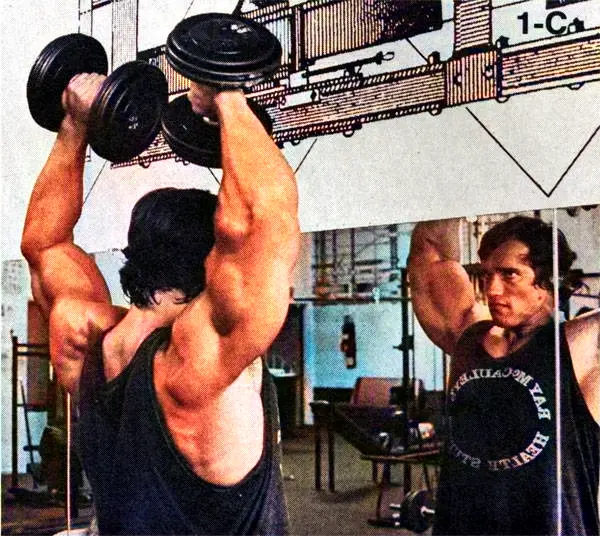
While the Arnold press, which is named after 7-time Mr. Olympia winner Arnold Schwarzenegger, is not a pre/rehab exercise like the Cuban press, it does engage all three heads of the deltoids, making it an acceptable alternative.
Also, with the Arnold press, you will probably be able to use heavier weights, so it’s a better exercise for hypertrophy (bodybuilding) than the Cuban press.
Read all about the Arnold press here.
4. Banded dumbbell victory raise
Where Cuban presses involve upright rows, external rotations, and overhead presses to work your shoulders, the banded dumbbell victory raise engages more or less the same muscles using one movement. If you aren’t too bothered about working your biceps and triceps with your deltoids, give this exercise a try.
How to do it:
- Put a lightweight mini-band around your wrists and hold a dumbbell in each hand. Rotate your wrists so your palms face inward. Hold the weights down in front of your hips. Brace your abs and pull shoulders down and back.
- Without bending your elbows, raise your arms forward, up, and overhead, pushing them out against the resistance of the band. At the top of the lift, your arms should make a wide V.
- Lower your arms and repeat.
- Do not relax between reps; maintain at least some outward pressure on the band.
- You can also do this exercise without dumbbells, focusing purely on raising and pushing your arms apart. This is a good option for home exercisers.
5. Prone incline dumbbell press
The prone incline dumbbell press primarily works your posterior deltoids, rhomboids, and middle trapezius. While not quite as comprehensive as the Cuban press, this is still an excellent exercise for shoulder health and better posture. Go light; this one is harder than it looks!
How to do it:
- Set an adjustable bench to around 45-degrees. With a dumbbell in each hand, lie face-down with your head uppermost. Raise the dumbbells to shoulder height, palms facing forward. Pull your shoulders down and back.
- Press the dumbbells forward and up to arms’ length, keeping your shoulders retracted and your arms in line with your torso.
- Return the weights to your shoulders and repeat.
6. Dumbbell YTI shoulder complex
The dumbbell YTI shoulder complex is a prehab exercise designed to increase shoulder strength and stability. The name refers to the shape you make with your arms as you work your way through the three different movements. This is a surprisingly challenging series of exercises, so go light until you get the hang of it.
How to do it:
- Set an adjustable bench to around 45-degrees. With a dumbbell in each hand, lie face-down with your head uppermost. Let your arms hang down, palms turned inward. Pull your shoulders down and back. Bend your elbows slightly but then keep them rigid for the duration of the exercise.
- Raise your arms forward and out to form a Y-shape. Make sure your thumbs are pointing up toward the ceiling. Lower your arms and repeat for the desired number of reps.
- Next, raise your arms up and out to the side, so they are perpendicular to your body and form a T-shape. Lower your arms and repeat.
- Finally, sweep your arms back and raise the dumbbells to your hips to form an I-shape. Lower your arms and repeat.
7. Face pull with external rotation
Face pulls are an effective posterior delt and mid-traps exercise that involves pulling back with your arms parallel to the floor, and your wrists, elbows, and shoulders, forming a straight line. Adding external rotation to face pulls turns a good exercise into a GREAT one and increases posterior deltoid and rotator cuff engagement.
How to do it:
- Attach a rope handle to a cable machine set to mid-chest height. Grab the handles with your thumbs nearest the ends. Extend your arms in front of you, adopting a standard or split stance as preferred. Brace your abs and pull your shoulders down and back.
- Bend your arms and pull the handles in toward your ears. As your hands near your face, externally rotate your shoulders and raise the handles toward the top of your head.
- Extend your arms and repeat.
Wrapping Up
Because of the levers involved, you probably won’t be able to use a lot of weight for Cuban presses, which means they’re not especially useful for building bigger muscles. That said, by increasing shoulder stability, mobility, and health, you should find that your bench press, bent-over row, and overhead press performances increase, which WILL lead to increased muscle size.
Do Cuban presses as part of your warm-up or as a finisher after upper body training. Whenever you do them, this exercise could be what’s missing from your upper body workouts.
Interested in measuring your progress? Check out our strength standards for Bench Press, Face Pull, Arnold Press, and more.


